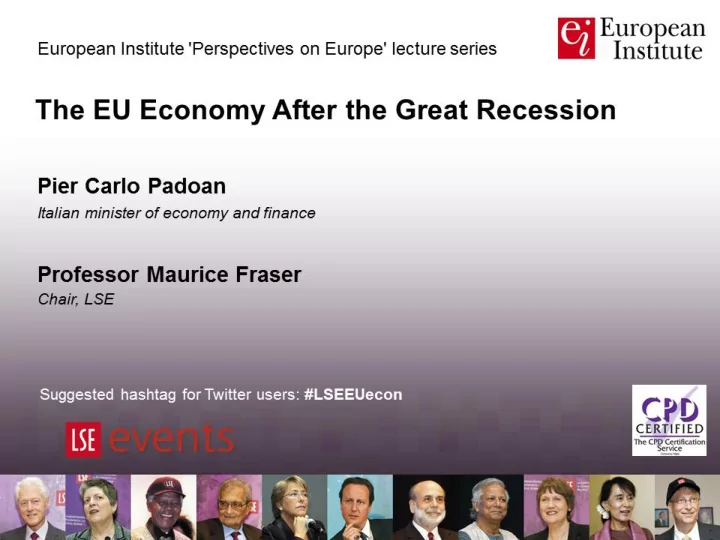

The EU economy after the great recession Pier Carlo Padoan, Italian Minister of Economy and Finance LSE Tuesday 29 April 2014
THE EUROPE’S ADJUSTMENT Eurozone adjustment: several dimension Fiscal consolidation Internal devaluation in the periphery Banking system repair A comprehensive common European growth strategy is still lacking 3
KEY FACTS GDP is recovering in core countries, but slower than in US. The periphery is still lagging 6.0% 4.0% GDP year-on-year 2.0% 0.0% -2.0% -4.0% -6.0% 2006Q1 2007Q1 2008Q1 2009Q1 2010Q1 2011Q1 2012Q1 2013Q1 Eurozone Core Periphery United States 4
KEY FACTS Domestic demand is recovering in core countries 6.0% 4.0% 2.0% 0.0% -2.0% -4.0% -6.0% 2006Q1 2007Q1 2008Q1 2009Q1 2010Q1 2011Q1 2012Q1 2013Q1 Eurozone Core Periphery 5
KEY FACTS Market confidence almost restored: interest rates are converging 45 40 Germany 35 Periphery (excluding Greece) 10 year govies yield Greece 30 25 20 15 10 5 0 6
KEY FACTS Credit fragmentation: little improvement 32 Euro Area Germany 28 Spain France Italy 24 20 Loans, % year-on-year 16 12 8 4 0 -4 -8 -12 -16 Feb-06 Feb-07 Feb-08 Feb-09 Feb-10 Feb-11 Feb-12 Feb-13 Feb-14 7
KEY FACTS Interest rates on loans: the gap is still wide 6.0 5.0 4.0 3.0 2.0 Germany Spain Italy Euro area France 1.0 Feb-06 Feb-07 Feb-08 Feb-09 Feb-10 Feb-11 Feb-12 Feb-13 Feb-14 8
KEY FACTS Public finances are now less vulnerable 4.0 3.0 2.0 Primary balance, % of GDP 1.0 0.0 -1.0 -2.0 -3.0 -4.0 -5.0 2006 2007 2008 2009 2010 2011 2012 2013 Eurozone Core Periphery 9
THE WEAK POINTS OF EUROPE Europe has lost market shares since 2004, well before the crisis 37 36 35 World trade share 34 33 32 31 30 29 28 2000 2001 2002 2003 2004 2005 2006 2007 2008 2009 2010 2011 2012 10
THE WEAK POINTS OF EUROPE The US economy has succeeded in defending its market share 2003 2012 USA 10.2% USA 10.7% China 13.5% China 6.5% Rest of the Rest of the word word Eurozone 58.6% 57.8% 34.9% Eurozone 28.7% 11
THE WEAK POINTS OF EUROPE Asymmetric correction of current account imbalances in the Eurozone 8 6 4 Percentage of GDP 2 0 -2 -4 -6 -8 -10 -12 2004 2005 2006 2007 2008 2009 2010 2011 2012 2013 Euro area Core Periphery United States Source: OECD. 12
THE WEAK POINTS OF EUROPE How much market reforms could foster economic growth The European Commission estimated that enforcing the Service Directive would boost GDP by 0.8% over a 5-10 year period (2.6% in case of full implementation) In Italy structural reforms already introduced would lead to 2.5% additional GDP in 2020 (of which 1.2% for liberalization and simplification) 13
THE WEAK POINTS OF EUROPE Product market regulation improving in Europe 1.8 2008 2013 1.7 1.6 1.5 1.4 1.3 1.2 1.1 1.0 Eurozone Core Periphery Source: OECD, Product Market Regulation Database. 14
THE WEAK POINTS OF EUROPE Output gap in the Eurozone still close to -3% 3 2 1.6 1 0 -1 -1.2 -2 -2.1 -2.2 -3 -3.0 -3.5 -4 -5 2008 2009 2010 2011 2012 2013 Source: European Commission. 15
THE WEAK POINTS OF EUROPE Low confidence and weak competition breed low investment and low investment breeds low growth 2.0 1.5 1.0 Contribution of investment 0.5 to GDP growth 0.0 -0.5 -1.0 -1.5 -2.0 -2.5 -3.0 2000 2001 2002 2003 2004 2005 2006 2007 2008 2009 2010 2011 2012 2013 2014 Eurozone United States Japan Source: Eurostat. 16
THE WEAK POINTS OF EUROPE Low investment implies weak innovation 3.0 2.8 R&D as percentage of GDP 2.5 2.3 2.0 1.8 1.5 1.3 1.0 2003 2004 2005 2006 2007 2008 2009 2010 2011 2012 Eurozone United States China Source: Eurostat. 17
THE WEAK POINTS OF EUROPE Weak growth of TFP in Europe 110 108 106 104 Index 2005=100 102 100 98 96 94 92 90 2000 2002 2004 2006 2008 2010 2012 2014 Eurozone USA Source: Eurostat. 18
THE WEAK POINTS OF EUROPE Increasing unemployment in Europe, mainly in peripheral countries 20.0 Percentage of active population 18.0 16.0 14.0 12.0 10.0 8.0 6.0 4.0 2.0 0.0 2004 2005 2006 2007 2008 2009 2010 2011 2012 2013 Euro area Periphery United States Source: Eurostat. 19
THE WEAK POINTS OF EUROPE Employment lagging in Europe, declining in peripheral countries 75.0 Percentage of active population 70.0 65.0 60.0 55.0 50.0 2004 2005 2006 2007 2008 2009 2010 2011 2012 2013 Euro area Periphery United States Source: Eurostat. 20
THE WEAK POINTS OF EUROPE Low growth and resource misallocation increase inequality. Inequality slows down consumption and growth 8.5 39.5 8.4 Poorest 20% (left scale) 39.3 Wealthiest 20% (right scale) 8.3 39.0 8.2 38.8 8.1 8.0 38.5 7.9 38.3 7.8 38.0 7.7 37.8 7.6 7.5 37.5 2004 2005 2006 2007 2008 2009 2010 2011 2012 2013 Note: Share of «equivalised» income in the Eurozone. Source: Eurostat, EU Silc. 21
Recommend
More recommend